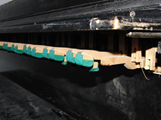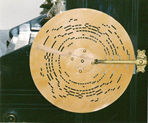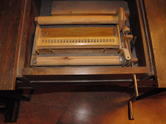We are still working with this site. Plaese, check the changes regularly. 
Ändra den här texten genom att klicka på "Redigera" |
Self-playing instruments
There are two main groups of music automats in our collections – auto pianos with pin-hole music rolls (hammers) and grind organs with pin-hole music discs (reed organs) or pin-hole rolls without keyboard (organette).
Auto pianos or roll players were common from the end of the 19th century. A mechanism is built into a usual piano that is operating pin-hole music rolls so that the keys are ’ghost playing’. Recordings made in this way are valuable sounding documents concerning playing technique and interpretation traditions. That is the reason why we also have separate rolls to piano roll players.
Another type of mechanical instrument is the player piano that is placed in front of a grand piano. The mechanism is here operating ‘mechanical fingers’ that play the keys.
Mechanical organs are usually equipped with cardboard or metal pin-hole music discs (Ehrlich’s patent). A self-playing reed organ without keyboard is called organette. In the Klaverens Hus there is one such instrument built into a desk, hence the name ‘Harmony desk’ (Swedish harmonipulpet, (‘HP’).
 |
 |
 |
 |
Auto piano by Steck (detail of the music roll)
|
Player piano (phonola) |
Pin-hole music disc for the J.P. Nyström reform organ (1890s) |
Harmony desk’, organette (‘HP, S. Ljungqvist, 1923)
|
Link (Excel):
List of self-playing instruments
|
|



